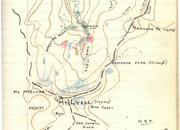About
How to Use
This exhibition is organized taxonomically and chronologically. Each section (birds, mammals, reptiles and amphibians) consists of three pages: 1) field work, 2) museum work, and 3) research, which trace the path of animals from the field, to the museum, and into the world of science. The exhibit explores changes in natural history practices during the twentieth century; the mammal section focuses on the beginning of the twentieth century, the bird section explores mid-century work, and the section on reptiles and amphibians centers on the latter part of the century. Despite this focus, the “museum work” page always provides a more general and up-to-date account of how specimens become a part of the Museum of Vertebrate Zoology’s permanent collections.
Project Summary
This web exhibit is one of the results of our larger effort to document the history of the Museum of Vertebrate Zoology (MVZ) since its 1908 establishment. Our collaborative, interdisciplinary project investigates the MVZ’s history from the era of its founding director, Joseph Grinnell, forward. Studying the MVZ provides a view of the transformations in twentieth-century American biology. As a university-based natural history museum, the MVZ offers a new dimension to existing historical accounts of the life sciences that are centered in university laboratories. Our project explores the unique character of the research that took place in natural history museums during the twentieth century.
Research Team
Cathryn Carson, University of California, Berkeley
James Griesemer, University of California, Davis
Elihu Gerson, Tremont Research Institute
Craig Moritz, University of California, Berkeley
Mary Sunderland, University of California, Berkeley
Karen Klitz, archivist, Museum of Vertebrate Zoology
Design by Genevieve Wong
Text by Mary Sunderland, Karen Klitz, and Kristine Yoshihara
Images from the archives of the Museum of Vertebrate Zoology, or, as indicated, by Karen Klitz.
MVZ Policy and Permission Use Form for Photos, Fieldnotes, Correspondence, and Other
Photographs, field notebook pages, correspondence, and other archival materials may not be reproduced, distributed, publicly displayed or otherwise used, in whole or in part, without written permission from the MVZ. These materials may be reprinted and distributed for academic and other uses with express written permission. No materials may be used for financial gain or resale.
When permission is given, materials may be used, downloaded, reproduced, publicly displayed, distributed or reprinted by persons affiliated with academic and/or non-profit organizations for scientific and scholarly purposes only, provided that the following attribution appears in all published use: "With the permission of The Museum of Vertebrate Zoology, University of California, Berkeley."
Use of photographs or other MVZ materials on personal or academic web sites must be authorized by the Museum. Images must be credited to the “Museum of Vertebrate Zooology, UC Berkeley.”
Publication permission is given for ONE TIME USE only.
Physical copies of MVZ written materials and photographs are charged at cost. There is no charge for the use of online/electronic materials. To submit a request, contact mvzarchives@berkeley.edu. We also ask that you complete our Permission Use Form (PDF file) and fax it to Carla Cicero/Michelle Koo at 510-643-8238.
How to Cite
Doing Natural History: The Journey of an Animal in the Museum of Vertebrate Zoology. 2011. Berkeley, California. Available http://mvz.berkeley.edu/DoingNaturalHistory (Accessed: insert date).
Contact
Send questions and comments to: mvzarchives@berkeley.edu
Acknowledgments
This material is based upon work supported by the National Science Foundation under Grant No. 0823401.
For generous advice on the content, and for comments on the text, we thank: Monica Albe, Carla Cicero, Chris Conroy, James Patton, Michelle Koo, and Carol Spencer.
